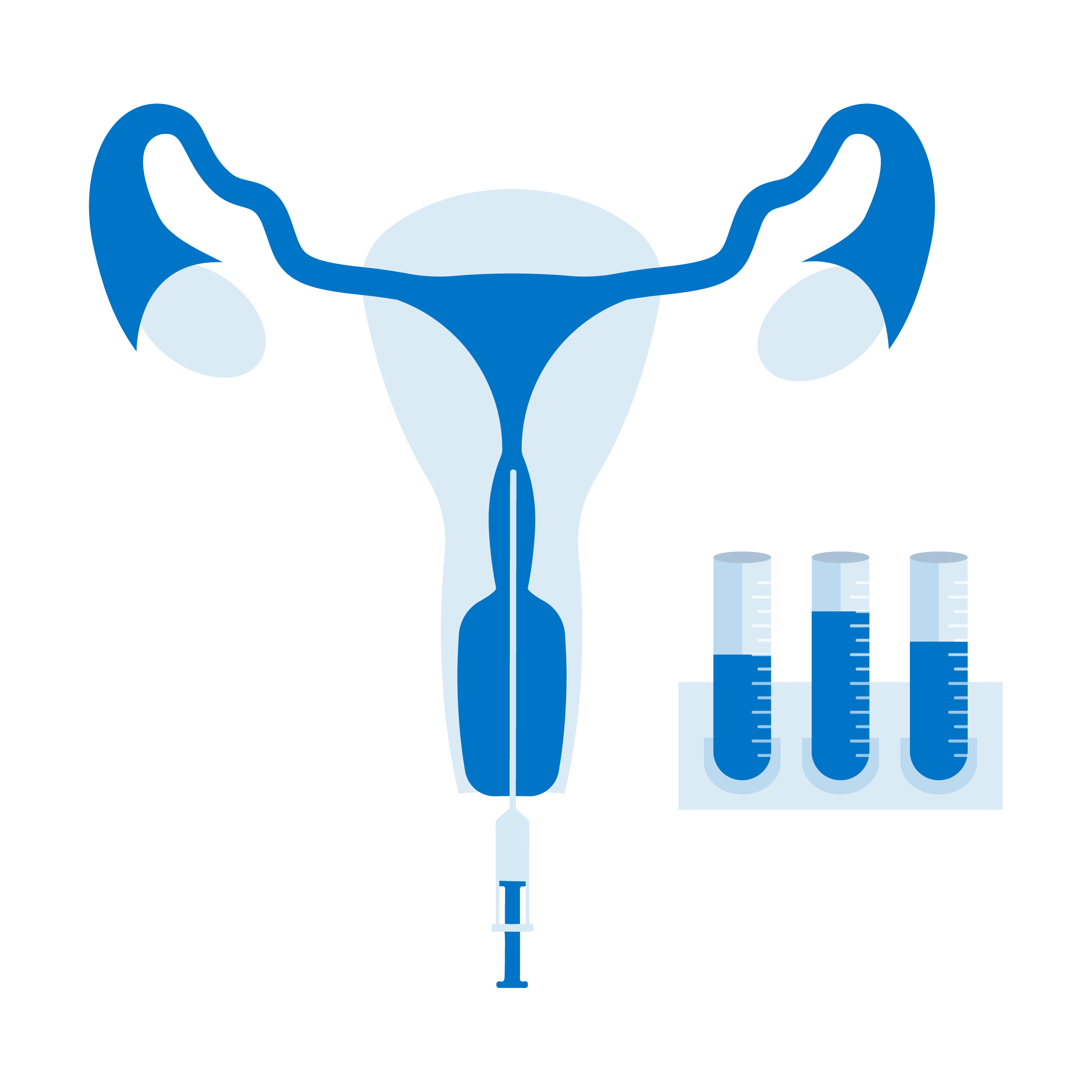
Why is Fallopian Tubes Evaluation Important?
Evaluating the fallopian tubes is essential for women who are experiencing difficulties conceiving or who have had recurrent miscarriages. Identifying any blockages, scarring, or abnormalities in the fallopian tubes can help healthcare providers determine the best course of treatment.

Common Reasons for Fallopian Tubes Evaluation
Tubal factor infertility accounts for a significant percentage of infertility cases. Fallopian tubes evaluation helps identify if blocked or damaged tubes are preventing conception.
Conditions like pelvic inflammatory disease (PID), sexually transmitted infections (STIs), or endometriosis can cause scarring and blockages in the fallopian tubes.
A previous ectopic pregnancy (where the embryo implants in the tube instead of the uterus) can damage the fallopian tubes, increasing the risk of future complications.
When the cause of infertility is not clear, evaluating the fallopian tubes can provide insights.
+ Procedure: HSG is an X-ray procedure where a contrast dye is injected into the uterus through the cervix. The dye flows into the fallopian tubes, allowing for X-ray imaging to check for blockages or abnormalities.
+ Benefits: HSG provides a clear view of the fallopian tubes’ structure and can detect blockages, scarring, or other abnormalities.
+ Considerations: Some women may experience discomfort or cramping during the procedure, and there is a small risk of infection.
+ Benefits: HSG provides a clear view of the fallopian tubes’ structure and can detect blockages, scarring, or other abnormalities.
+ Considerations: Some women may experience discomfort or cramping during the procedure, and there is a small risk of infection.
+ Procedure: This is an ultrasound-based test where sterile saline is injected into the uterus, expanding the uterine cavity and improving the visualization of the fallopian tubes.
+ Benefits: SHG is non-invasive and can help identify blockages or structural issues in the fallopian tubes and uterus.
+ Considerations: It is generally well-tolerated, though some women may experience mild cramping.
+ Benefits: SHG is non-invasive and can help identify blockages or structural issues in the fallopian tubes and uterus.
+ Considerations: It is generally well-tolerated, though some women may experience mild cramping.
+ Procedure: Laparoscopy is a minimally invasive surgical procedure where a thin, lighted tube (laparoscope) is inserted through a small incision in the abdomen. This allows direct visualization of the fallopian tubes, ovaries, and other pelvic organs.
+ Benefits: Laparoscopy provides the most detailed view of the fallopian tubes and can identify and sometimes treat conditions like endometriosis or adhesions.
+ Considerations: It is a surgical procedure, requiring anesthesia, with associated risks such as infection, bleeding, or injury to surrounding organs.
+ Benefits: Laparoscopy provides the most detailed view of the fallopian tubes and can identify and sometimes treat conditions like endometriosis or adhesions.
+ Considerations: It is a surgical procedure, requiring anesthesia, with associated risks such as infection, bleeding, or injury to surrounding organs.
+ Procedure: A blood test that checks for antibodies to chlamydia, an STI that can cause damage to the fallopian tubes.
+ Benefits: A positive result can indicate previous chlamydia infection, which may have caused tubal damage, warranting further investigation.
+ Considerations: This test does not directly visualize the tubes but provides an indirect indication of possible tubal damage.
+ Benefits: A positive result can indicate previous chlamydia infection, which may have caused tubal damage, warranting further investigation.
+ Considerations: This test does not directly visualize the tubes but provides an indirect indication of possible tubal damage.
Methods of Fallopian Tubes Evaluation
Methods of Fallopian Tubes Evaluation
+ Procedure: HSG is an X-ray procedure where a contrast dye is injected into the uterus through the cervix. The dye flows into the fallopian tubes, allowing for X-ray imaging to check for blockages or abnormalities.
+ Benefits: HSG provides a clear view of the fallopian tubes’ structure and can detect blockages, scarring, or other abnormalities.
+ Considerations: Some women may experience discomfort or cramping during the procedure, and there is a small risk of infection.
+ Benefits: HSG provides a clear view of the fallopian tubes’ structure and can detect blockages, scarring, or other abnormalities.
+ Considerations: Some women may experience discomfort or cramping during the procedure, and there is a small risk of infection.
+ Procedure: This is an ultrasound-based test where sterile saline is injected into the uterus, expanding the uterine cavity and improving the visualization of the fallopian tubes.
+ Benefits: SHG is non-invasive and can help identify blockages or structural issues in the fallopian tubes and uterus.
+ Considerations: It is generally well-tolerated, though some women may experience mild cramping.
+ Benefits: SHG is non-invasive and can help identify blockages or structural issues in the fallopian tubes and uterus.
+ Considerations: It is generally well-tolerated, though some women may experience mild cramping.
+ Procedure: Laparoscopy is a minimally invasive surgical procedure where a thin, lighted tube (laparoscope) is inserted through a small incision in the abdomen. This allows direct visualization of the fallopian tubes, ovaries, and other pelvic organs.
+ Benefits: Laparoscopy provides the most detailed view of the fallopian tubes and can identify and sometimes treat conditions like endometriosis or adhesions.
+ Considerations: It is a surgical procedure, requiring anesthesia, with associated risks such as infection, bleeding, or injury to surrounding organs.
+ Benefits: Laparoscopy provides the most detailed view of the fallopian tubes and can identify and sometimes treat conditions like endometriosis or adhesions.
+ Considerations: It is a surgical procedure, requiring anesthesia, with associated risks such as infection, bleeding, or injury to surrounding organs.
+ Procedure: A blood test that checks for antibodies to chlamydia, an STI that can cause damage to the fallopian tubes.
+ Benefits: A positive result can indicate previous chlamydia infection, which may have caused tubal damage, warranting further investigation.
+ Considerations: This test does not directly visualize the tubes but provides an indirect indication of possible tubal damage.
+ Benefits: A positive result can indicate previous chlamydia infection, which may have caused tubal damage, warranting further investigation.
+ Considerations: This test does not directly visualize the tubes but provides an indirect indication of possible tubal damage.

What to Expect During a Fallopian Tubes Evaluation
Preparation
Depending on the procedure, you may be asked to avoid eating or drinking for several hours before the test. For HSG or SHG, scheduling during a specific time in your menstrual cycle may be recommended.
During the Procedure
Most tests are outpatient procedures. HSG and SHG are performed in a clinical setting, while laparoscopy requires a surgical suite and anesthesia.
After the Procedure
You may experience mild cramping or spotting after HSG or SHG. Recovery from laparoscopy typically involves rest and monitoring for any signs of complications.
Fallopian tubes evaluation is a critical step in diagnosing and treating infertility. By assessing the health and patency of the fallopian tubes, healthcare providers can better understand the underlying causes of fertility issues and tailor treatment plans to help achieve a successful pregnancy. If you have concerns about your reproductive health or are struggling to conceive, talk to your healthcare provider about whether fallopian tubes evaluation is appropriate for you.
Get An Appointment
Your information is safe with us. We respect and protect your privacy. We will not rent, sell or share your personal information with outside companies for their promotional use. We will not distribute your personal information to outside parties without your consent.

Ready to Take the Next Step?
Understanding your fertility health is the first step toward achieving your dream of parenthood. Let us provide you with the answers and guidance you need.

